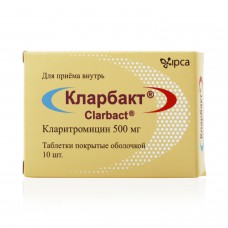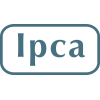Expiration date: 11/2025
Release form and composition:
Tablets, coated from white to almost white, capsule-shaped, with a dividing risk on one side of the fracture - the core of white or almost white, coated.
1 tablet contains:
clarithromycin 250 mg
Excipients: cellulose microcrystalline, starch maize, starch Pregelatinised, polyvinylpyrrolidone, talc purified, sodium starch of glycolate, silicon dioxide colloidal, stearic acid, magnesium stearate.
The composition of the shell: isopropanol, hydroxypropyl methylcellulose, titanium dioxide, purified talc, polyethylene glycol 6000, methylene chloride, lemon flavor, peppermint powder.
4 PCs. - blisters (1) - packs cardboard.
10 PCs. - blisters (1) - packs cardboard.
Tablets, coated from white to almost white, capsule-shaped, with a dividing risk on one side of the fracture - the core of white or almost white, coated.
1 tablet contains:
clarithromycin 500 mg
Excipients: cellulose microcrystalline, starch maize, starch Pregelatinised, polyvinylpyrrolidone, talc purified, sodium starch of glycolate, silicon dioxide colloidal, stearic acid, magnesium stearate.
The composition of the shell: isopropanol, hydroxypropyl methylcellulose, titanium dioxide, purified talc, polyethylene glycol 6000, methylene chloride, lemon flavor, peppermint powder.
4 PCs. - blisters (1) - packs cardboard.
10 PCs. - blisters (1) - packs cardboard.
Pharmacological action:
Antibiotic macrolides of the second generation broad-spectrum antimicrobial action. It has bacteriostatic effect. Violates the protein synthesis of microorganisms associated with the 50S subunit membrane ribosomes of microbial cells.
Clarithromycin is active against Streptcccus agaactiae (Streptcccus pygenes, Streptcccus viridans, Sreptcccus pneumniae), Haemphius infuenae (parainfuenae), Haemphius ducreyi, Neisseria gnrrheae, Neisseria meningitidis, Listeria mncytgenes, Leginea pneumphia, Mycpasma pneumniae, Heicbacter (Campibacter) pyri, Campibacter jejuni, Chamidia pneumniae (trachmatis), Mraxea (Branhamea) catarrhais, Brdetea pertussis, Prpinibacterium acnes, Staphycccus aureus, Ureapasma ureayticum, Txpasma gndii, Crynebacterium spp., Brreia burgdrferi, Pasteurea mutcida, some anaerobes (Eubacterium spp., Peptcccus spp, Prpinibacterium spp., Cstridium perfringens, Bacterides meaningenicus) and all mycobacteria (including Mycbacterium avium, Mycbacterium eprae) except Mycbacterium tuberculosis.
Pharmacokinetics:
Suction
After ingestion, the absorption is quick. Food slows absorption, without significant effect on the bioavailability. Bioavailability clarithromycin in the form of a suspension is equivalent to or slightly higher than when taken in tablets.
After a single dose recorded 2 of the peak Cmax. The second peak is due to the ability of the drug to concentrate in the gallbladder, followed by gradual or rapid release. Time to reach Cmax when administered at a dose of 250 mg is 1-3 hours.
Distribution and metabolism
The plasma protein binding is more than 90%.
After oral administration, 20% of the dose quickly hydroxylated in the liver with the participation of cytochrome P450 isozymes to form the main metabolite - 14-hydroxyclarithromycin, which has a pronounced antimicrobial activity against Haemphius infuenae.
With regular intake of 250 mg / day Css unchanged drug and its main metabolite - 1 and 0.6 mg/ml, respectively T1/2 3-4 h and 5-6 h, respectively. By increasing the dose to 500 mg / day Css unchanged drug and its metabolite in plasma-2.7-2.9 and 0.83-0.88 mg/ ml, respectively T1/2 - 4.8-5 h and 6.9-8.7 h, respectively. In therapeutic concentrations, it accumulates in the lungs, skin and soft tissues (concentrations 10 times higher than serum levels).
Breeding
It is excreted in the kidneys and feces (20-30% - unchanged, the rest – in the form of metabolites). With a single dose of 250 mg and 1.2 g with urine output 37.9 and 46%, with feces - 40.2 and 29.1%, respectively.
Indications:
Treatment of infectious diseases caused by drug-sensitive microorganisms:
- infections of the lower respiratory tract (bronchitis, pneumonia)
- infections of the upper respiratory tract (pharyngitis, sinusitis)
- otitises
- infections of the skin and soft tissues (folliculitis, erysipelas)
- common or localized mycobacterial infections caused by Mycbacterium avium and Mycbacterium intraceuare
- localized infections caused by Mycbacterium chenae, Mycbacterium frtuitum and Mycbacterium kansasii
- for eradication Heicbacter pyri and reduction of recurrence of duodenal ulcers.
Dosage regimen:
The drug is taken orally.
For adults, the average dose is 250 mg 2 times / day. If necessary, you can assign 500 mg 2 times / day. The duration of treatment is 6-14 days.
Children drug administered at a dose of 7.5 mg / kg body weight per day. The maximum daily dose is 500 mg.The duration of treatment is 7-10 days.
For the treatment of infections caused by Mycbacterium avium, the drug is prescribed orally 1 g 2 times / day. The duration of treatment can be 6 months or more.
In patients with renal insufficiency (CC less than 30 ml/min) dose should be reduced by 2 times. The maximum duration of treatment in patients of this group is 14 days.
Side effect:
From the digestive system: most often-nausea, dyspepsia, abdominal pain, vomiting and diarrhea possible pseudomembranous colitis (from moderate to life-threatening), taste disorders and transient increase in liver enzymes, glossitis, stomatitis, candidiasis of the oral mucosa, changing the color of the tongue during treatment with clarithromycin, changing the color of the teeth (in most cases, reversible) rarely - hepatitis with an increase in the level of liver enzymes in the blood, the development of cholestasis and jaundice (these liver injuries in some cases were severe and usually reversible) in isolated cases - liver failure with a fatal outcome.
From the Central and peripheral nervous system: possible transient headache, dizziness, anxiety, fear, fear, insomnia, nightmares, tinnitus, confusion, hallucinations, psychoses and depersonalization rarely – paresthesia.
On the part of the senses: possible hearing loss (restored after discontinuation of the drug), changes in perception of taste, usually occur with taste impairment.
From the cardiovascular system: rarely-an increase in THE Qt interval, ventricular arrhythmia (including ventricular paroxysmal tachycardia, trembling or flickering of the ventricles).
From the urinary system: rarely - increased serum creatinine, interstitial nephritis, renal failure.
From the hematopoietic system: in some cases – thrombocytopenia, leukopenia.
Allergic reactions: when ingestion, urticaria, skin rash, anaphylactic reactions, Stevens-Johnson syndrome are possible.
Other: rarely-hypoglycemia (in some cases, while taking oral hypoglycemic agents or insulin).
Contraindications:
- severe disturbances of liver function
- severe renal impairment
- concurrent use of ergot alkaloids
- simultaneous use of cisapride, pimozide, astemizole, terfenadine
- hypersensitivity to antibiotics from the group of macrolides.
Pregnancy and lactation:
The safety of clarithromycin during pregnancy and lactation has not been established.
Therefore, during pregnancy, Clarbact is prescribed only in the absence of alternative therapy, if the intended benefit exceeds the possible risk to the fetus.
Clarithromycin is excreted in breast milk, so you should use the drug with caution during lactation.
Special instruction:
In the presence of chronic liver diseases, it is necessary to conduct regular monitoring of liver enzymes.
With caution, prescribed on the background of taking drugs that are metabolized in the liver, it is recommended to determine their concentration in blood plasma.
In case of joint application with warfarin or other indirect anticoagulants, prothrombin time should be controlled.
Cardiac history is not recommended simultaneous reception of with terfenadine, cisapride, astemizole.
Attention should be paid to the possibility of cross-resistance between clarithromycin and other antibiotics from the macrolide group, as well as lincomycin and clindamycin.
With prolonged or repeated use of the drug may develop superinfection (growth of insensitive bacteria and fungi).
Overdose:
Symptoms: nausea, vomiting, diarrhea, headache, confusion.
Treatment: immediate gastric lavage and symptomatic treatment are required. Hemodialysis and peritoneal dialysis do not lead to a significant change in serum clarithromycin levels.
Drug interaction:
While the use of clarithromycin increases the blood concentration of drugs metabolized in the liver with the participation isozymes of cytochrome P450: indirect anticoagulants, carbamazepine, theophylline, triazolam, midazolam, cyclosporine, disopyramide, phenytoin, rifabutin, lovastatin, digoxin, ergot alkaloids.
With simultaneous use with clarithromycin, there is a significant increase in the concentration of cisapride, pimozide, astemizole and terfenadine (2-3 times) in blood plasma, with the possible prolongation of the QT interval and the development of cardiac arrhythmias, including ventricular paroxysmal tachycardia, ventricular fibrillation and fluttering or ventricular flicker (this combination is contraindicated).
Rare cases of acute necrosis of skeletal muscles, coinciding in time with the simultaneous administration of clarithromycin and inhibitors of HMG-COA reductase-lovastatin and simvastatin are reported.
There are reports of an increase in the concentration of digoxin in plasma in patients receiving both digoxin and clarithromycin tablets. In such patients, it is necessary to constantly monitor the content of digoxin in the serum to avoid digitalis intoxication.
Clarithromycin can reduce the clearance of triazolam and thus increase its pharmacological effects with the development of drowsiness and confusion of consciousness.
The simultaneous use of clarithromycin and ergotamine (ergot alkaloids) can lead to acute ergotamine intoxication, manifested by severe peripheral vasospasm and impaired sensitivity.
Co-administration to HIV-infected adults inside and zidovudine tablets clarithromycin can lead to a decrease in Css alone. Given that clarithromycin is likely to alter the absorption of simultaneously administered zidovudine, this interaction is largely avoided when taking clarithromycin and zidovudine at different times of the day (at intervals of at least 4 hours).
When concomitant administration of clarithromycin and ritonavir increases the values of serum concentrations of clarithromycin. Correction dose clarithromycin in these cases for patients with normal renal function is not required. However, in patients with creatinine clearance 30 to 60 ml/min the dose of clarithromycin should be reduced by 50%. When KK less 30 ml/min the dose of clarithromycin should be reduced by 75%. While treatment with ritonavir should not be administered clarithromycin in doses more than 1 g/day.
Storage conditions and terms:
List B. the Drug should be stored out of reach of children, dry, dark place at a temperature below 25°C. shelf Life – 2 years.


